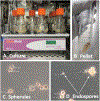Proper Care and Feeding of Coccidioides: A Laboratorian's Guide to Cultivating the Dimorphic Stages of C. immitis and C. posadasii
- PMID: 32894648
- PMCID: PMC9976608
- DOI: 10.1002/cpmc.113
Proper Care and Feeding of Coccidioides: A Laboratorian's Guide to Cultivating the Dimorphic Stages of C. immitis and C. posadasii
Abstract
Coccidioidomycosis ("Valley fever") is caused by Coccidioides immitis and C. posadasii. These fungi are thermally dimorphic, cycling between mycelia and arthroconidia in the environment and converting into spherules and endospores within a host. Coccidioides can cause a broad spectrum of disease that can be difficult to treat. There has been a steady increase in disease, with an estimated 350,000 new infections per year in the United States. With the increase in disease and difficulty in treatment, there is an unmet need to increase research in basic biology and identify new treatments, diagnostics, and vaccine candidates. Here, we describe protocols required in any Coccidioides laboratory, such as growing, harvesting, and storing the different stages of this dimorphic fungal pathogen. © 2020 Wiley Periodicals LLC. Basic Protocol 1: Growth and harvest of liquid mycelia cultures for extractions Alternate Protocol 1: Large-volume growth and harvest of liquid mycelia cultures Basic Protocol 2: Mycelial growth on solid medium Alternate Protocol 2: Maintaining mycelial growth on solid medium Basic Protocol 3: Harvesting and quantification of arthroconidia Alternate Protocol 3: Long-term storage of arthroconidia Basic Protocol 4: Parasitic spherule growth and harvest Alternate Protocol 4: Obtaining endospores from spherules Basic Protocol 5: Intranasal infection of murine models.
Keywords: BSL-3; Coccidioides; arthroconidia; dimorphic fungi; endospores; mycelia; spherules.
© 2020 Wiley Periodicals LLC.
Figures









Similar articles
-
Life Cycle Dominates the Volatilome Character of Dimorphic Fungus Coccidioides spp.mSphere. 2021 Apr 14;6(2):e00040-21. doi: 10.1128/mSphere.00040-21. mSphere. 2021. PMID: 33853870 Free PMC article.
-
Optimizing in vitro spherulation cues in the fungal pathogen Coccidioides.mSphere. 2025 Jan 28;10(1):e0067924. doi: 10.1128/msphere.00679-24. Epub 2024 Dec 17. mSphere. 2025. PMID: 39688406 Free PMC article.
-
Arthroconidia in coccidioidoma: case report and literature review.Int J Infect Dis. 1998 Jul-Sep;3(1):32-5. doi: 10.1016/s1201-9712(98)90092-3. Int J Infect Dis. 1998. PMID: 9831673 Review.
-
Parasitic polymorphism of Coccidioides spp.BMC Infect Dis. 2014 Apr 21;14:213. doi: 10.1186/1471-2334-14-213. BMC Infect Dis. 2014. PMID: 24750998 Free PMC article.
-
Coccidioidomycosis: host response and vaccine development.Clin Microbiol Rev. 2004 Oct;17(4):804-39, table of contents. doi: 10.1128/CMR.17.4.804-839.2004. Clin Microbiol Rev. 2004. PMID: 15489350 Free PMC article. Review.
Cited by
-
Transcriptional Analysis of Coccidioides immitis Mycelia and Spherules by RNA Sequencing.J Fungi (Basel). 2021 May 7;7(5):366. doi: 10.3390/jof7050366. J Fungi (Basel). 2021. PMID: 34067070 Free PMC article.
-
Developing a Coccidioides posadasii and SARS-CoV-2 Co-infection Model in the K18-hACE2 Transgenic Mouse.Commun Med (Lond). 2024 Sep 30;4(1):186. doi: 10.1038/s43856-024-00610-y. Commun Med (Lond). 2024. PMID: 39349727 Free PMC article.
-
Host tracheal and intestinal microbiomes inhibit Coccidioides growth in vitro.Microbiol Spectr. 2024 Jul 2;12(7):e0297823. doi: 10.1128/spectrum.02978-23. Epub 2024 Jun 4. Microbiol Spectr. 2024. PMID: 38832766 Free PMC article.
-
B Cell Chronic Lymphocytic Leukemia Development in Mice with Chronic Lung Exposure to Coccidioides Fungal Arthroconidia.Immunohorizons. 2023 May 1;7(5):333-352. doi: 10.4049/immunohorizons.2300013. Immunohorizons. 2023. PMID: 37195872 Free PMC article.
-
Humanization and expression of IgG and IgM antibodies in plants as potential diagnostic reagents for Valley Fever.Front Plant Sci. 2022 Sep 2;13:925008. doi: 10.3389/fpls.2022.925008. eCollection 2022. Front Plant Sci. 2022. PMID: 36119630 Free PMC article.
References
-
- Baptista-Rosas RC, Catalán-Dibene J, Romero-Olivares AL, Hinojosa A, Cavazos T, & Riquelme M (2012). Molecular detection of Coccidioides spp. from environmental samples in Baja California: Linking Valley Fever to soil and climate conditions. Fungal Ecology, 5(2), 177–190. doi: 10.1016/j.funeco.2011.08.004. - DOI
-
- Campuzano A, Zhang H, Ostroff GR, Dos Santos Dias L, Wuthrich M, Klein BS, … Hung CY (2020). CARD9-associated Dectin-1 and Dectin-2 are required for protective immunity of a multivalent vaccine against Coccidioides posadasii infection. Journal of Immunology, 204(12), 3296–3306. doi: 10.4049/jimmunol.1900793. - DOI - PMC - PubMed
Publication types
MeSH terms
Substances
Grants and funding
LinkOut - more resources
Full Text Sources
Medical

